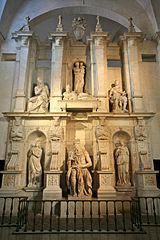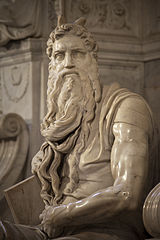
Wikimedia Commons: Alex Proimos
Recently, I was eating lunch with a couple of Zen Buddhist nuns and a few other practitioners. I have NO idea how the topic turned to the devil and horns, but if you ever find yourself at a loss for words while dining with nuns, there’s a conversation topic for you. One of the nuns interjected, “So how is that related to Moses being depicted with horns?” HUH??! “Oh, yeah,” she said, “it has something to do with some weird thing in Exodus.” Unable to add anything intelligent, we all moved on to another topic, but it turns out she was exactly right.

Wikimedia Commons: Westerdam
The most famous version of Moses-with-horns is a marble sculpture by Michelangelo. The statute is part of a large, 2-story tomb commissioned in 1505 by Pope Julius II for himself. Located in San Pietro in Vincoli (St. Peter in Chains) church in Rome, the Moses sculpture is seated in the center alcove of the lower level; he is flanked by Rachel and Leah (probably carved by students). The statue of Moses is arguably Michelangelo’s greatest work – a “frighteningly powerful” figure with muscular arms, an intense expression on his face, and an amazing beard which has been described as “ropy and smoky.” And there, plain as day, on top of his head, are two small horns.
To determine what the horns symbolize, we have to back up a bit, historically-speaking, to the Middle Ages. There were always times when Moses was depicted without horns. However, art historians have found that during the final centuries of the Middle Ages (circa 1200-1500), there was a sharp increase in the prevalence of such imagery. This is probably why horned Moses images show up in some of the great Gothic cathedrals of Europe, including Chartres and Notre Dame, which were constructed during this time frame.
Interestingly, the Middle Ages also mark the time period when the devil was coming into modern-day form. The devil is never clearly described in the Bible. In the Old Testament/Hebrew Bible, the devil is described as an adversary, an accuser, or even as a Day Star. In the New Testament, the devil is described as a tempter. The closest we get to a tangible description is a passage from Revelation.
And war broke out in heaven; Michael and his angels fought against the dragon. The dragon and his angels fought back, but they were defeated, and there was no longer any place for them in heaven. The great dragon was thrown down, that ancient serpent, who is called the Devil and Satan, the deceiver of the whole world – he was thrown down to the earth, and his angels were thrown down with him. (Revelation 12:7-9)
With little to go on from the Bible, images of the devil were created, largely through art and theater. By the final centuries of the Middle Ages, the devil was beginning to appear with the prototypical red coloring holding a trident-type weapon and outfitted with a tail and horns. Many scholars of both religious and art history agree that these representations purposefully morphed Satan with various pagan gods. The most obvious candidate is Pan/Faunus. Pan was the Greek god of nature and the wild. Faunus was the Roman god of the forest and fields. By the Middle Ages, the two deities had been conflated for centuries. Both were regularly depicted as human from the waist up with the hooves, legs, and horns of a goat. In fact, all the satyrs/fauns that accompanied them were depicted in a similar manner. Conveniently, horns are also mentioned in conjunction with two additional beasts briefly described in Revelation. One arose from the land; the other from the sea. Both had horns.
Then the dragon took his stand on the sand of the seashore. And I saw a beast rising out of the sea, having ten horns and seven heads; and on its horns were ten diadems, and on its heads were blasphemous names. (Revelation 12:18 and 13:1)
Then I saw another beast that rose out of the earth; it had two horns like a lamb and it spoke like a dragon. It exercises all the authority of the first beast on its behalf, and it makes the earth and its inhabitants worship the first beast, whose mortal wound had been healed. (Revelation 13:11-12)
Of course, the latter part of the Middle Ages also coincided with the Crusades and then the Inquisition. Both promoted anti-Semitic sentiments that lasted, in one form or another, for centuries. But displaying anti-Semitism with a horned Moses would be rather out of character for Michelangelo. There is no evidence that he depicted any other characters from the Hebrew Bible in that manner, and that includes the figures of Rachel and Leah that appear on the very same tomb – not to mention the statue of David and all the other Old Testament figures he painted over the years.
Moreover, the trend for depicting a horned Moses was somewhat passé by the time Michelangelo carved his Moses in the early 1500s. All of this prompted me to revisit those “weird things in Exodus,” my Buddhist nun friend had mentioned. It turns out that the conundrum hinges on the translation of Exodus 34:29. Here’s the verse from my New Revised Standard Version of the Bible:
Moses came down from Mount Sinai. As he came down from the mountain with the two tablets of the covenant in his hand, Moses did not know the skin of his face shone because he had been talking with God.
Nothing about horns there. For that, we have to go back to the Vulgate. This gold-standard, Latin version of the Bible was created by St. Jerome in the 4th century. In it, Jerome tried to reconcile the various Latin versions already available (mostly translated from Aramaic and Greek) with the Hebrew texts. The Hebrew text used the word “karan” based on the root “keren,” which can mean “horn.” Jerome’s Latin version therefore used the word “cornuta” which was translated to “horned” when the Vulgate was finally published in English in the early 1600s. Here’s what that version says:
And when Moses came down from the Mount Sinai, he held the two tables of the testimony, and he knew not that his face was horned from the conversation of the Lord.
There is a fair bit of evidence that Jerome knew the Hebrew word “karan” was a metaphor for “glorified.” Moreover, it seems that by the Renaissance period, many people, including Michelangelo, would have known that as well.
If we assume that Michelangelo had no intention of dissing the Jews or Moses, and we assume that he was familiar with this passage, we are left with a couple of possibilities. The first is that Michelangelo wanted to show – clearly and unequivocally – that Moses was the friend of God, the one who had seen God face-to-face and lived to tell about it. The horns don’t really look like the horns of a goat, and they wouldn’t necessarily bring Satan to mind. Instead, the horns potentially capture both the literal and the metaphorical interpretations of Exodus 34:29, and both versions show that Moses was special. But the second possibility is also intriguing. In an early sketch for the tomb of Pope Julius II, the Moses figure is shown sitting about 12 feet off the ground. Art historians have suggested that this is why the torso is so long, the facial expression so intense, and the upper arms so disproportionate. All of these features would have been normalized when viewing the figure from below. From that angle, it has been posited that the horns themselves would not have been visible at all. Instead, the viewer would have seen only the light reflected off them. In other words, Michelangelo would have used the literal interpretation to create the metaphorical interpretation. If that the case, Michelangelo was not just an artistic genius, he was a theological genius, as well.
Sources
Holy Bible: New Revised Standard Version. San Francisco, CA: HarperOne, 2007. Print.
Vulgate.org. The Holy Bible in Latin Language with Douay-Rheims English Translation. Web. 29 October, 2014. <http://vulgate.org/>